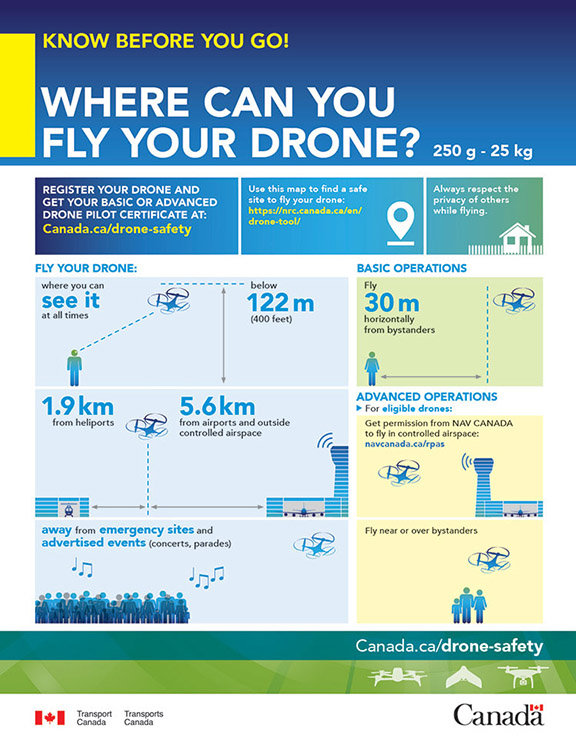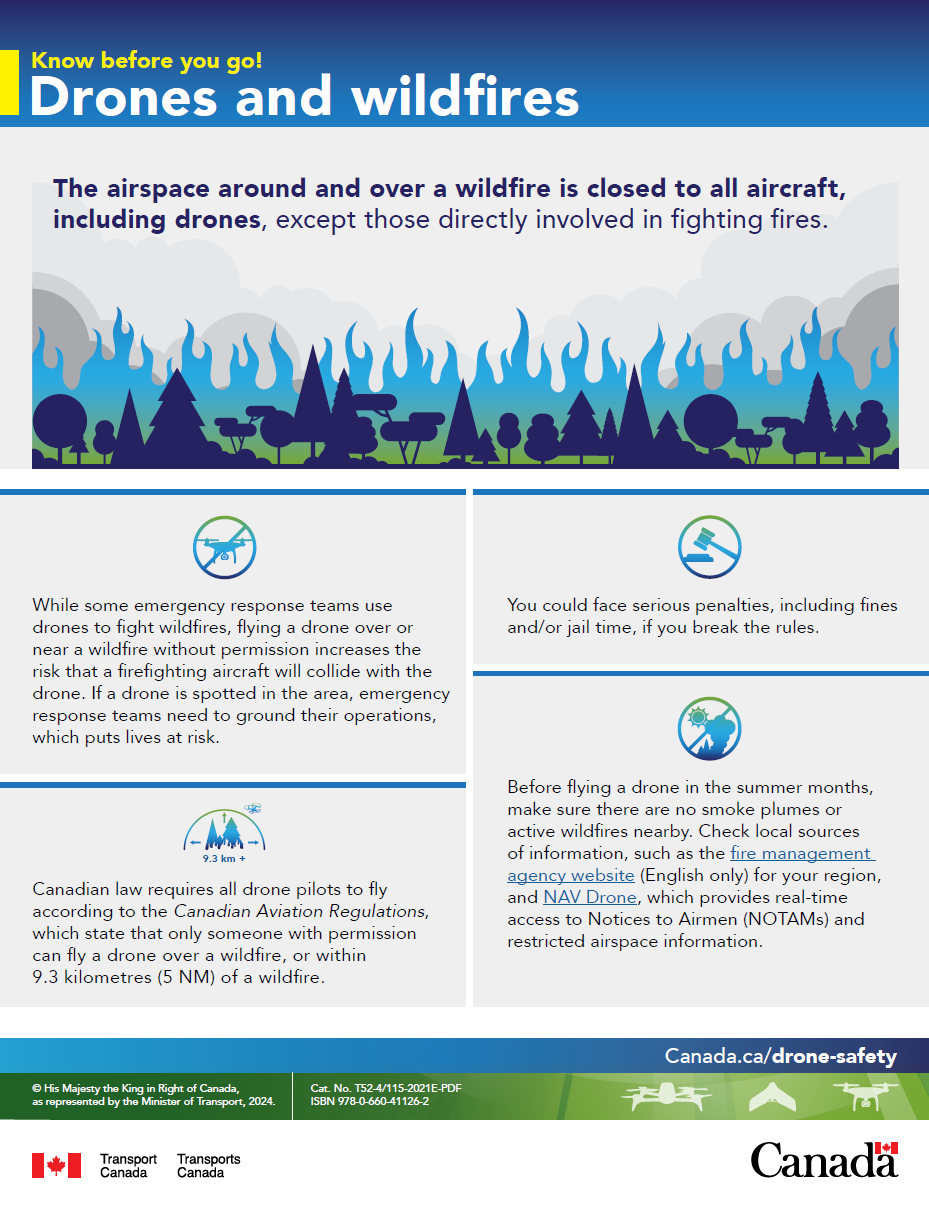Drones share airspace with other drones and aircraft. Knowing where to fly your drone is an important part of keeping the skies safe.
On this page
Check an interactive map
The National Research Council has created an interactive map where you can fly. The map helps drone operators understand airspace and find out where to fly.
It is for your convenience only.
Sharing airspace
If you fly a drone in Canada, you must follow the rules that help keep people and aircraft safe.
All drone operations
Prior to each flight, drone pilots must conduct a survey of the area and also consult:
- Notice to Airmen (NOTAMs) for the flight location: NAV CANADA NOTAMs portal
- the Canada Flight Supplement
- the Designated Airspace Handbook
- appropriate aeronautical charts
NOTAMs tell pilots about event and obstacles that may affect them. All NOTAMs include the time and location of the event. Enter the ID of an aerodrome near you into the NAV CANADA NOTAMs portal to find NOTAMs in your area.
Any chart that has aeronautical information relevant to the flight will do. This may include aeronautical charts listed on the NAV CANADA website.
Flying in controlled airspace
To operate within controlled airspace, drone pilots need an advanced RPA pilot certificate, a drone with the appropriate manufacturer safety declaration, and the air navigation service provider authorization.
Drone pilots must maintain communications with the air traffic control authority while flying. For more information on operations in controlled airspace, please visit section 3.4.4 of the RPA chapter of Transport Canada Aeronautical Information Manual (AIM).
Airspace controlled by NAV CANADA
Drone pilots holding an Advanced Operations Pilot Certificate can request permission to fly their drone in airspace controlled by NAV CANADA through the NAV Drone app. Download the app on your mobile device on the Drone Flight Planning page.
Users can also access interactive maps or the NAV Drone Viewer to obtain airspace information and see where they can and cannot fly their drone.
Airspace under the authority of the Minister of National Defence (MND)
You must request a flight authorization from the appropriate aerodrome authorities, this information can be found in the Canada Flight Supplement (CFS), on the NRC Drone Site Selection Tool.
Areas where drone use is limited or restricted
Drones are considered aircraft under the Aeronautics Act and Canadian Aviation Regulations and are therefore prohibited to enter the following zones without the proper authorizations:
- Class F Special Use Restricted Airspace
- Over a wildfire area or any area located within five nautical miles of a wildfire area, or in any airspace for which a NOTAM for Forest Fire Aircraft Operating Restrictions has been emitted
- Zones where a 5.1 of the Aeronautics Act restrict the use of airspace to all aircraft has been emitted
Airports, heliports and aerodromes
An aerodrome is anywhere that an aircraft can take off and land. This includes airports, heliports, and seaplane bases.
Unless you are following an established Transport Canada procedure, you cannot fly closer than:
- 5.6 kilometres (3 nautical miles) from any airport listed as Certified (“Cert”) in the Canada Flight Supplement
- 1.9 kilometres (1 nautical mile) from heliports listed as Certified (“Cert”) in the Canada Flight Supplement
Airport, water airport or heliports outside of controlled airspace
There are steps you must follow if you are flying in airspace not controlled by NAV CANADA or Minister of National Defence, but you will fly within 3 nautical miles of a certified airport or within 1 nautical mile from a certified heliport.
To do this, you must:
- always have a valid drone pilot certificate - advanced operations
- comply with Transport Canada established procedures.
Transport Canada established procedures can be found in the section 3.4.5 of the RPA chapter of Transport Canada Aeronautical Information Manual (AIM), and on the NRC Drone Site Selection tool.
Operations within 3 nautical miles of a Department of National Defense (MND) aerodrome
Drone operations within 3 nautical miles (5.6 kilometers) of an aerodrome under the authority of the MND require a Special Flight Operations Certificate (SFOC) - RPAS. To be issued a SFOC-RPAS, the drone pilot must receive authorization from the MND aerodrome authorities.
For more information about these zones and how to properly access them, please consult the NRC Drone Site Selection tool and section 3.2.35 of the RPA chapter of Transport Canada Aeronautical Information Manual (AIM).
National parks
Drone pilots are not allowed to take-off or land within a national park.
A park superintendent may allow the use of drones in some cases. If you want to fly a drone in a national park, read about the use of drones at Parks Canada places and contact Parks Canada.
Emergency sites
Drone pilots are not allowed to fly within the security perimeter of a police or first responder emergency operation, such as a traffic accident. You must also avoid sites near disasters (wildfires, floods, earthquakes). A drone flying near these areas may interfere with emergency personnel aircraft and the work of emergency personnel.
Advertised events
Drone pilots are not allowed to fly near or over advertised events, such as outdoor concerts and sporting events, unless they have a Special Flight Operations Certificate that specifically allows them to do so.
Indoors, underground, near and over buildings
Part IX of the Canadian Aviation Regulations do not apply to indoor or underground drone operations. No matter where you fly, however, you must fly safely and always respect all other laws so as not to pose danger to people or other aircraft. Before you fly indoors, or near or over buildings, we recommend getting permission from the building owner and/or occupants.
Related links
Know before you go!
Where can you fly your drone?
(PDF 628 Kb)
Text description
Know before you go!
Where can you fly your drone? 250 g – 25 kg
Register your drone and get your basic or advanced drone pilot certificate at: Canada.ca/drone-safety
Use this map to find a safe site to fly your drone: https://nrc.canada.ca/en/uav-site-selection/
Always respect the privacy of others while flying
Fly your drone:
- where you can see it at all times
- below 122 m (400 ft)
- 1.9 km from heliports / 5.6 km from airports and outside controlled airspace
- away from emergency sites and advertised events (concerts, parades)
Basic operations:
- Fly 30 m horizontally from bystanders
Advanced operations:
For eligible drones
- Get permission from NAV CANADA to fly in controlled airspace: navcanada.ca/rpas
- Fly near or over bystanders
Know before you go!
Drones and wildfires
(PDF 309 Kb)
Text description
Know before you go!
Drones and wildfires
The airspace around and over a wildfire is closed to all aircraft, including drones, except those directly involved in fighting fires.
While some emergency response teams use drones to fight wildfires, flying a drone over or near a wildfire without permission increases the risk that a firefighting aircraft will collide with the drone. If a drone is spotted in the area, emergency response teams need to ground their operations, which puts lives at risk.
Canadian law requires all drone pilots to fly according to the Canadian Aviation Regulations, which state that only someone with permission can fly a drone over a wildfire, or within 9.3 kilometres (5 NM) of a wildfire.
You could face serious penalties, including fines and/or jail time, if you break the rules.
Before flying a drone in the summer months, make sure there are no smoke plumes or active wildfires nearby. Check local sources of information, such as the fire management agency website (English only) for your region, and NAV Drone, which provides real-time access to Notices to Airmen (NOTAMs) and restricted airspace information.

